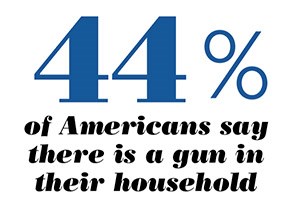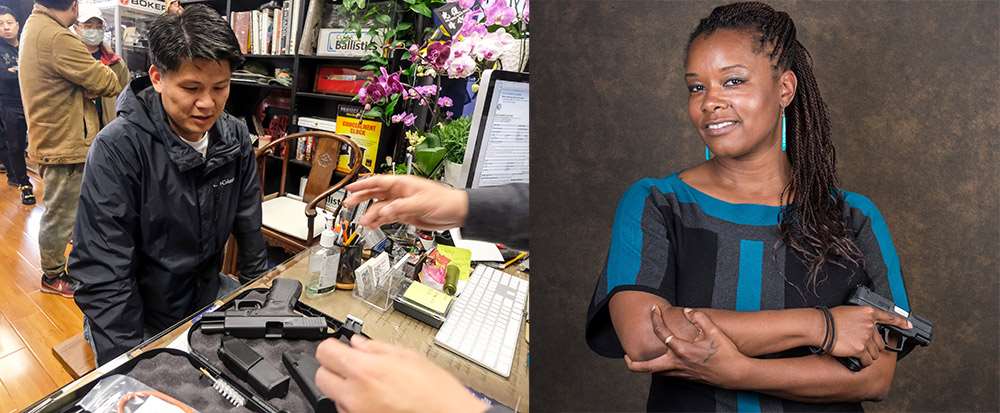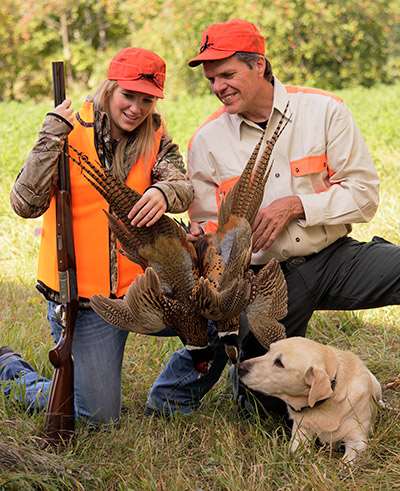
Many in the mainstream media and in Hollywood have long painted a stereotypical portrait of the American gun owner: He is supposed to be an old, balding, poorly educated white guy, possibly with a Southern accent. But, while the anti-Second Amendment legacy press may be more interested in politically useful (to them) parodies than in opening their eyes and minds, the truth is that the real and very law-abiding American gun culture is much larger and more diverse than they like to report.
First and foremost, the Second Amendment of the U.S. Constitution recognizes the right to keep and bear arms of all law-abiding citizens; indeed, according to Pew Research, at least one-third of adults exercise this right. A Gallup poll conducted last October found that 44% of Americans say there is a gun in their household and that 30% say they personally own a gun. And, as many have argued in the pages of America’s 1st Freedom, these numbers are likely low because it seems probable that quite a few gun owners would decline to tell some stranger calling that they own a gun or have one in their home.
 Meanwhile, last October, a Gallup survey also found that 64% of people said that having a gun in their home made them safer—this, despite the fact that gun-control groups and many in the media have been falsely claiming for decades now that guns in the home make people less safe.
Meanwhile, last October, a Gallup survey also found that 64% of people said that having a gun in their home made them safer—this, despite the fact that gun-control groups and many in the media have been falsely claiming for decades now that guns in the home make people less safe.
Despite the media spin, what the millions of new gun owners since 2020 are finding is that the lawful firearm community is incredibly open and diverse.
So, let’s take a deep dive into gun making, selling and use across this diverse swath of the American population to see what is really happening in America.
Figures recently released by the U.S. Bureau of Alcohol, Tobacco, Firearms and Explosives (ATF) “guesstimate” that American civilians own roughly 422.9 million firearms—or about 1.2 guns per person. Handguns now comprise the majority of purchases—about 57%, according to the National Shooting Sports Foundation (NSSF). While ammunition sales are a little more complicated to estimate per capita, the ATF asserts that in 2022, the gun sector produced 8.1 billion rounds of ammunition.
That’s a lot of Americans exercising their rights by owning and shooting a lot of guns. And these citizens belong to a wide range of age groups and ethnicities and live in every state and city. Such diversification became even more pronounced amid the COVID pandemic and the unrest in 2020 when millions bought their first guns.
Many of the new gun owners are women; for example, the Well Armed Woman, a coalition of female gun owners, has expanded to 300 chapters across 43 states with more than 20,000 members. For most women, possessing a firearm comes down primarily to self-protection.
Regan Wolfe, a young professional from Tennessee, is just one of many women who recently acquired her first gun, a Smith & Wesson .380.
“It is empowering. I go out of town often with my friends on road trips to different places. It is usually just me and a girlfriend,” she said. “We are all in our twenties, and I wanted to feel safer knowing that if I got a flat tire or ended up in a bad part of town, I have something to protect myself with.”
Her sister Rachel, younger by two years, also purchased her first firearm at the same time. As a university student, Rachel pointed to the increasing threats on campus. She emphatically stated she no longer wants to feel like a “sitting duck” waiting for a criminal to target her or some group she is in. The sisters and their cousin took training classes and vowed to do whatever it took to keep themselves safe.

Texas native Kat Joel-Reich knows firsthand what it is to be rendered helpless. One day in 2014, just after 3 a.m., she and her husband, both in their 60s at the time, were the victims of a home invasion and assault.
“Our door was broken down, and my husband was brutally assaulted while I hid in the house making the 911 call,” she said. “At that time, I did not believe you needed a firearm unless you were military or police. So, we didn’t have any guns in the house. Lucky for us, our 911 response time was six minutes in total. The police arrived and saved the day. But it is not always as quick as six minutes, and those six minutes seemed like forever. It was brutal.”
A week later, Kat took her first class in self-defense with a firearm and never looked back.
The firearms community has also expanded in recent years to include many more black Americans who have grown tired of the soft-on-crime policies implemented by many Left-leaning officials. In 2020, black Americans purchased firearms at a 58% higher rate than in 2019, according to data from the NSSF. Yet even before such a clamorous year, many were already turning toward legal gun possession. In 2015, black American gun-enthusiast Philip Smith founded the National African American Gun Association. Each new member learns about the extensive history of gun ownership in the black community.
It is often lost in public literature that the Second Amendment was pivotal during the Civil Rights movement of the 1950s and 1960s. This constitutional right, which is colorblind, enabled many black Americans, especially in the rural South, to defend themselves, their families, their neighbors and their broader communities. Now, there are chapters, often multiple, of the National African American Gun Association in almost every state and even in the District of Columbia, totaling more than 120 chapters that have more than 48,000 members. That marks a sharp rise from 2019, when there were 30,000 members and 75 chapters.
In particular, black American women have recently emerged as one of the fastest-growing groups of new owners. Nearly half of the new gun owners from the 2020 spike were women, and a fifth of those were black. And, as the Institute for Women’s Policy Research points out, black women experience higher rates of domestic violence than other racial groups.
Jessica Royal, then Cothon, has experienced this firsthand. Her personal firearm saved her life. As a new mother trapped in an abusive relationship, the Nashville native quietly obtained her concealed-carry permit and prayed that she would never need to pull that trigger; however, the jarring worst-case scenario came two days after Christmas in 2013.
“That night, he set out to kill me,” said Jessica, remembering how her partner gripped his hands tight around her neck and how the room blurred and her life flashed before her eyes as her three young children slept nearby.

Despite the fog of painful memories, some moments remain crystal clear. Jessica screamed to her mother to call 911. But, even as she did, she knew it would take many minutes for law enforcement to arrive, and she saw something different in her ex’s intoxicated eyes that night, something she hadn’t seen before.
“Something came over me. A question was running through my mind: What would my babies do without me?” said Jessica. “I knew I had to fight with everything I had.”
Jessica stumbled to her feet and grabbed her handgun from a nearby drawer. As her partner stormed toward her, she pulled that trigger.
“It was like something out of the matrix; everything was just floating,” said Jessica. “I had gone into survival mode, but it was his life or mine. And I chose mine.”
Jessica does not regret her decision. There is no guilt, she says, only immense appreciation for a renewed lease on life.
A December 2021 study published by the American College of Physicians also reported that roughly half of new firearms owners are women and half are a racial minority. Again, that is a massive shift from the “old white man” stereotype. Hispanic American purchases also rose by 49% and Asian American purchases rose by 42% in recent years, according to the NSSF.
Chris Cheng, a California-based Asian-American competitive shooter who won Season 4 of the History Channel’s Top Shot show, has long urged his fellow community members to purchase a firearm. Cheng also represents another minority concerned about backlash and safety. He came out as openly gay many years ago and now works to dispel the media myth about gun ownership only being for a certain type of person.
“What has been particularly interesting to see is that many of my friends and acquaintances in ‘liberal anti-gun’ parts of the Bay Area have been considering and purchasing their first firearms,” he said.
Moreover, a report published in 2022 by the Statista Research Department documented that at least one in five Democrats own a minimum of one firearm and a further 31% reside in a household with a gun. While this is less than the roughly 48% of Republicans who own at least one gun and the 66% who live in a gun-owning home, it still shows the diversity of those who exercise their Second Amendment rights. There is even an official “Liberal Gun Club” with an ever-expanding 31 chapters across 35 states. Its mission is “to provide a pro-Second Amendment voice for left-of-center gun owners in the national conversations on firearms.”

The reasons why so many are exercising their Second Amendment rights have a relatively common denominator. A 2021 Gallup survey found that 88% of U.S. firearms owners view protection against crime as the primary reason for making such a purchase. A further 70% also see target shooting as a key reason, while 56% cited hunting.
American gun owners also contribute to the economy. The gun and ammunition industry pays more than $7.85 billion in business taxes yearly, including property, income and sales-based levies; however, the NSSF emphasizes that the total economic impact of the firearm and ammunition industry in the U.S. reached $70.52 billion in 2021, a 269% jump compared to $19.1 billion in 2008.
In particular, hunters and recreational shooters contribute more than $45 billion in wages and income to support nearly one million jobs and they spend over $90 billion every year on trips. Every time a recreational shooter or hunter purchases a gun, ammunition or related equipment, they must pay an 11% excise tax under the decades-old Federal Aid in Wildlife Restoration Act, which is commonly known as the Pittman-Robertson Act and is nearly 90 years old. These taxes have generated over $14 billion since 1937, averaging some $800
million annually in recent years.
According to Statista, there were around 15.9 million hunting-license holders in the U.S. in 2023, compared to 15.4 million the year before. There were nearly 39 million hunting licenses, tags, permits and stamps issued in the U.S. over the course of the past year. The revenue generated pays for the salaries of state agency employees who manage wildlife conversation and who help to keep wildlife viewing free and accessible to the public.
Without the voluntary conservation efforts of America’s hunting enthusiasts, the health of our wildlife and the habitat they use would be very different.
Montana boasts the highest gun-ownership rate per capita, followed by Wyoming, West Virginia and Idaho. At the bottom of the list are Hawaii, New Jersey and Massachusetts.
But, regardless of one’s location, the gun-owning world has always been incredibly open and has long promoted the importance of solid training and safety. Thus, the number of training opportunities—whether tailored for beginners or the very experienced—is abundant across America. The NRA trains more than a million people in the U.S. annually and features a network of “more than 125,000 instructors, 8,000 coaches and 2,200 training counselors.” You can find many near you by going to NRAInstructors.org and typing in your zip code.
Finally, many of those who don’t currently own a firearm refuse to rule out the prospect of buying a gun for self-defense; for example, the Pew Research Center notes that almost half (42%) of Americans who don’t currently own a firearm “could imagine themselves as gun owners in the future.” The report also stated that “56% of black non-owners say they could see themselves owning a gun one day, compared with smaller shares of white (48%), Hispanic (40%) and Asian (38%) non-owners.”
While there is a lot of talk in the media these days about how Americans are “more divided than ever,” one thing is certain: the Second Amendment is a freedom issue that has the power to unite more than divide. The 100-million-plus U.S. citizens who exercise this natural right occupy a much broader spectrum of the country than many in the mainstream media and some politicians want the American public to know.


































